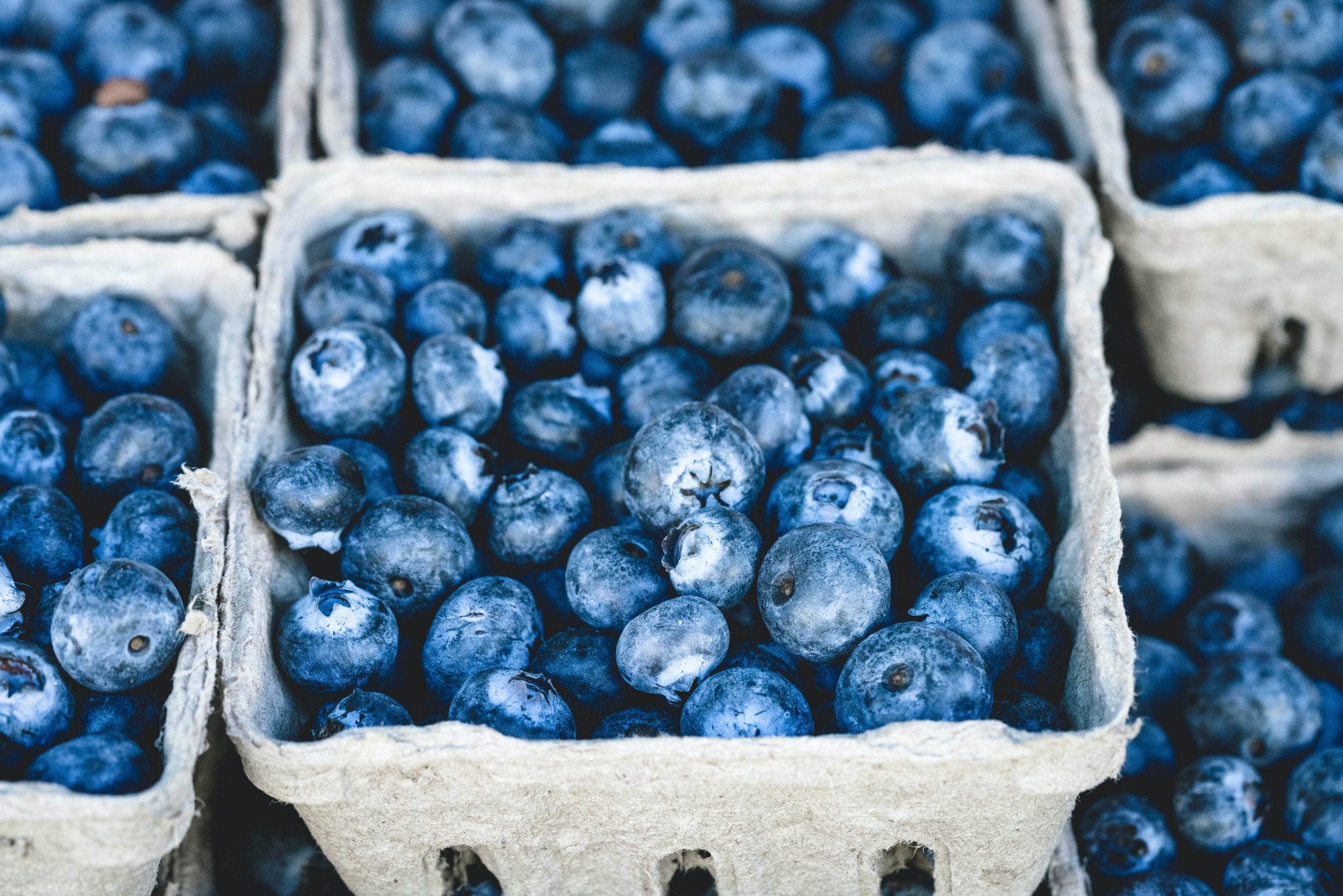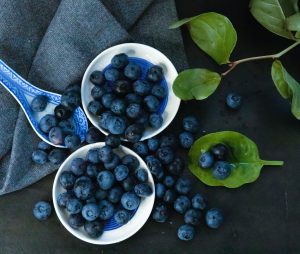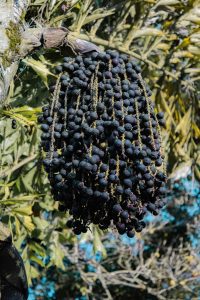
What Are Blueberries?
Blueberries are small, round, and sweet berries that belong to the Vaccinium genus, encompassing various species. Known for their vibrant blue-purple hue, blueberries are not only delicious but also packed with nutritional benefits. These tiny fruits are rich in antioxidants, particularly anthocyanins, which contribute to their distinctive color and offer potential health advantages. Blueberries are low in calories and high in vitamins C and K, as well as manganese.
Cultivated globally, blueberries thrive in acidic soils and are native to North America. They are enjoyed in a myriad of culinary applications, from fresh consumption to inclusion in salads, smoothies, baked goods, and desserts. Blueberry cultivation has expanded due to their recognized health benefits, making them a popular addition to a balanced diet. Additionally, frozen and dried blueberries extend their availability beyond the growing season. Blueberries hold cultural significance and are celebrated in various festivals and events worldwide. With their delightful taste and nutritional profile, blueberries have become a beloved and versatile fruit enjoyed by people of all ages.
Why Do We Eat Blueberries?
People eat blueberries for a variety of reasons, ranging from their delicious taste to their numerous health benefits. Here are some key reasons why blueberries are a popular and enjoyed fruit:
- Rich in Antioxidants:
- Blueberries are renowned for their high antioxidant content, particularly anthocyanins, which contribute to their deep blue-purple color. Antioxidants help combat oxidative stress and inflammation in the body.
- Nutrient-Rich:
- Blueberries are low in calories but high in essential nutrients, including vitamin C, vitamin K, and manganese. They also provide dietary fiber, promoting digestive health.
- Heart Health:
- Regular consumption of blueberries has been associated with cardiovascular benefits, such as lower blood pressure and reduced risk of heart disease, attributed to their anthocyanin and flavonoid content.
- Brain Health:
- Some studies suggest that the antioxidants in blueberries may have positive effects on cognitive function and may help delay age-related cognitive decline.
- Anti-Inflammatory Properties:
- The compounds in blueberries have anti-inflammatory properties, potentially reducing inflammation in the body and lowering the risk of chronic diseases.
- Versatility in Culinary Use:
- Blueberries can be enjoyed in various forms, including fresh, frozen, dried, or in processed products like jams, juices, and baked goods. Their versatility makes them a popular ingredient in a wide range of dishes.
- Delicious Taste:
- Blueberries have a sweet and slightly tart flavor, making them a tasty snack on their own or a delightful addition to a variety of recipes, from breakfast dishes to desserts.
- Cultural and Culinary Significance:
- Blueberries are celebrated in various culinary traditions and events, and they hold cultural significance in different regions. They are often featured in festivals, recipes, and traditions that highlight their importance.
- Year-Round Availability:
- Thanks to advancements in cultivation and global trade, blueberries are available year-round in many regions, allowing people to enjoy their benefits at any time.
Overall, the combination of delicious taste, nutritional richness, and potential health benefits makes blueberries a popular and widely consumed fruit in various culinary and dietary contexts.
When Do We Eat Blueberries?
Blueberries are enjoyed throughout the year, and the timing of consumption can depend on various factors, including the region, cultivation methods, and personal preferences. Here are some considerations regarding when people commonly eat blueberries:
- Summer Harvest:
- In many temperate regions, blueberries are in peak season during the summer months, typically from late spring to early autumn. This is when local, fresh blueberries are abundant and at their peak in terms of flavor and nutritional content.
- Year-Round Availability:
- Due to advancements in agricultural practices, blueberries are now available year-round in many parts of the world. In regions where blueberries are not in season, they may be imported from areas where they are currently harvested.
- Frozen Blueberries:
- Frozen blueberries are available year-round and are often used in various culinary applications. They retain much of their nutritional value and can be a convenient and versatile option when fresh blueberries are not in season.
- Processed Products:
- Blueberries are used to create various processed products, such as jams, jellies, juices, and baked goods. These products allow for blueberry consumption beyond the fresh fruit’s typical season.
- Culinary Events and Festivals:
- Blueberries are sometimes featured in culinary events and festivals that celebrate the harvest season. These events often showcase creative recipes and dishes that highlight the versatility of blueberries.
- Snacking and Culinary Uses:
- Blueberries can be enjoyed in a variety of ways, including fresh in salads, added to breakfast cereals or yogurt, blended into smoothies, or used as a topping for desserts. The timing of consumption depends on individual meal preferences and dietary habits.
Ultimately, people eat blueberries whenever they are available, whether fresh, frozen, or in processed forms. The fruit’s popularity and versatility contribute to its consumption throughout the year in various culinary contexts.
Ingredients of Blueberries
Blueberries are simple, whole fruits that don’t require any additional ingredients. However, if you’re referring to the nutritional composition or components found in blueberries, here are the main elements:
- Water:
- Blueberries have a high water content, contributing to their juiciness.
- Carbohydrates:
- The majority of the calories in blueberries come from carbohydrates, mainly natural sugars like fructose.
- Dietary Fiber:
- Blueberries are a good source of dietary fiber, which is essential for digestive health and helps maintain a feeling of fullness.
- Vitamins:
- Blueberries contain various vitamins, with vitamin C being a notable component. They also provide smaller amounts of vitamins like vitamin K and vitamin B-complex (such as B6, niacin, riboflavin, and folate).
- Minerals:
- Blueberries offer essential minerals, including manganese, potassium, magnesium, phosphorus, and calcium.
- Antioxidants:
- Blueberries are rich in antioxidants, particularly anthocyanins, which give them their characteristic blue-purple color. Antioxidants help combat oxidative stress in the body.
- Phytonutrients:
- Blueberries contain phytonutrients, which are plant compounds with potential health benefits. These include flavonoids, quercetin, and resveratrol.
- Natural Sugars:
- While blueberries contain natural sugars, they have a relatively low glycemic index, making them a suitable fruit for those mindful of their sugar intake.
It’s important to note that the specific nutritional composition of blueberries can vary slightly based on factors such as ripeness, growing conditions, and the specific variety of blueberry. Overall, blueberries are not only delicious but also nutrient-dense, making them a healthy addition to a balanced diet.
Types of Blueberries
There are several varieties of blueberries, each with its own unique flavor profile, size, and growing characteristics. Here are some common types of blueberries:
- Highbush Blueberries (Vaccinium corymbosum):
- ‘Bluecrop’: A popular commercial variety known for its high yield and sweet flavor.
- ‘Jersey’: Produces medium to large berries with a sweet and mild flavor.
- ‘Duke’: Known for its early ripening and large, flavorful berries.
- ‘Elliot’: A late-season variety with a sweet and mild taste.
- Lowbush Blueberries (Vaccinium angustifolium):
- ‘Top Hat’: A dwarf variety suitable for container gardening, producing small, sweet berries.
- ‘Northblue’: Cold-hardy and compact, this variety yields small, flavorful berries.
- Rabbiteye Blueberries (Vaccinium virgatum or Vaccinium ashei):
- ‘Climax’: A popular rabbiteye variety with large, sweet berries.
- ‘Tifblue’: Known for its productivity and large berries with a sweet and tangy flavor.
- Southern Highbush Blueberries (Hybrids of V. corymbosum and other species):
- ‘Sunshine Blue’: A compact variety suitable for mild climates, producing sweet and tangy berries.
- ‘Misty’: Known for its early harvest and sweet berries.
- Half-High Blueberries (Hybrids of V. corymbosum and V. angustifolium):
- ‘Northcountry’: Cold-hardy with small, sweet berries.
- ‘Northsky’: Another compact variety, ideal for smaller gardens, with flavorful berries.
- Wild Blueberries (Vaccinium myrtillus):
- Wild blueberries are smaller and have a more intense flavor compared to cultivated varieties. They are often found growing naturally in certain regions.
These are just a few examples, and there are many more blueberry varieties, each adapted to different climates and growing conditions. The choice of blueberry type often depends on factors such as climate, soil conditions, and personal preferences for taste and size.
Signs of Ripe, Signs of Raw and Signs of Rotten Blueberries
Signs of Ripe Blueberries:
- Color:
- Ripe blueberries have a deep, uniform blue-purple color. Depending on the variety, they may also have a slight frosty appearance.
- Firmness:
- Ripe blueberries should be plump and firm to the touch. They should yield slightly to gentle pressure without being overly soft or mushy.
- Cluster Texture:
- When inspecting blueberries still attached to their cluster or stem, ripe ones will be firmly attached and not easily dislodged.
- Sweet Aroma:
- Ripe blueberries emit a sweet and pleasant aroma. If they have a noticeable fragrance, it’s a good indication that they are ready to eat.
Signs of Unripe Blueberries:
- Color:
- Unripe blueberries are often green or pale in color, indicating that they haven’t fully developed their characteristic blue-purple hue.
- Firmness:
- Unripe blueberries will be hard to the touch and lack the characteristic plumpness of ripe berries.
- Sour Taste:
- Unripe blueberries tend to be more tart or sour in taste compared to their sweet, ripe counterparts.
- Cluster Texture:
- Unripe blueberries may be easier to detach from the stem, as they have not fully matured.
Signs of Rotten Blueberries:
- Mold:
- Rotten blueberries may develop mold, which can appear as fuzzy white or gray patches. Discard blueberries with visible mold.
- Soft or Wrinkled Texture:
- Rotten blueberries become soft, mushy, or wrinkled. If the texture feels off and the berry is no longer firm, it may be spoiled.
- Offensive Odor:
- Rotten blueberries emit a strong, unpleasant odor. If the blueberries smell bad, they are likely spoiled.
- Dark or Discolored Areas:
- Dark spots, bruising, or unusual discoloration are signs of deterioration. Check for these on the surface of the blueberries.
- Leaking Juice:
- Excessive juice or a wet, sticky feel can be a sign of overripeness or spoilage.
When selecting blueberries, look for those with a vibrant blue-purple color, firm texture, and a sweet aroma. Proper storage in the refrigerator can help extend the shelf life of ripe blueberries.
Summary
Blueberries, belonging to the Vaccinium genus, are small, round berries celebrated for their vibrant blue-purple hue and delectable taste. Packed with antioxidants, particularly anthocyanins, they offer numerous health benefits. These nutrient-rich berries contain vitamins C and K, manganese, and dietary fiber. Thriving in various climates, blueberries are enjoyed fresh, frozen, or in processed forms like jams and juices. Common varieties include Highbush, Lowbush, and Rabbiteye, each with unique flavors and characteristics. Recognized for their heart and brain health benefits, blueberries are a versatile culinary delight, featured in salads, desserts, and smoothies. Whether enjoyed in-season during summer or year-round, blueberries are cherished for their deliciousness and nutritional value.






